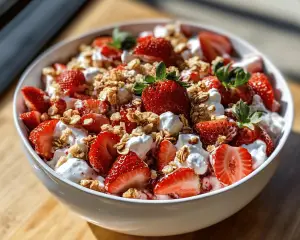I remember the first time I made **No-Oven Turkish Bread**; it was a chilly autumn afternoon, the kind where the air outside feels crisp and a little hauntingly beautiful, hinting that winter is just around the corner. My kitchen was warm, a comforting retreat from the greyness beyond my window. It had been a long week, and I decided I needed to do something that demanded my hands and heart. So, I flipped through my dog-eared cookbook, glancing for something simple yet nourishing, something that would fill my home with a welcoming aroma, something that felt like a warm hug.
That’s when I stumbled upon this recipe, tucked between pages worn from countless adventures in cooking. It promised a bread that came together without an oven but with enough character to give the false impression of extensive baking expertise. I was intrigued, and before I knew it, my hands were working the dough, meshing with flour and yeast, transforming ingredients into something tangible—something real.
I can still hear my mother’s voice in my mind as I sifted the flour through my fingers, softly reminding me, “Bread making is a soulful act. It’s not just about the ingredients; it’s about the love you put into it.” Her words echoed around the kitchen like an old song. I could feel her there with me, despite the miles and years that separated us.
That day, as I kneaded the dough, I began to weave my own memories into its texture. I remembered summer days spent with my grandmother in her small kitchen, watching her hands expertly roll dough while stories of her youth floated about like the flour that dusted our aprons. The scent of warm, fresh bread was a recurrent character in the landscape of my childhood—a reminder of happy times, weekends filled with family, laughter, and meals that seemed to stretch into eternity.
Inside the Ingredients of No-Oven Turkish Bread
Let’s take a closer look at what goes into making this remarkable bread—a kind of soft and pillowy indulgence you can whip up in mere moments, no high-tech kitchen appliance required.
All-Purpose Flour: Ah, flour—the foundation of our bread. It provides the structure and the backbone, working in tandem with water to create gluten. The result should be a dough that stretches and holds its shape. In my experience, using high-quality flour, whether bleached or unbleached, gives the best results. It’s tender yet plays strong, transforming into a gentle canvas upon which you can paint flavors.
Yeast: Yeast is the silent magician of our dough. It transforms plain flour and water into living, breathing bread. The first time I tried to make this bread without letting the yeast bloom—oh, the disaster! It was a flat, sad pancake, crumbling under the weight of my unbridled optimism. Patience is key here; a good ten minutes watching yeast bubble and froth is a small price to pay for yeasty happiness.
Water: A simple ingredient, but essential! Water hydrates the flour, initiating the glorious transformation from grain to dough. I’ve learned that using warm water helps activate the yeast, creating a cozy environment for it to thrive. The temperature needs to mimic a warm bath inviting a loved one in. Too hot, and the yeast dies; too cold, and it slumbers.
Salt: Nothing elevates a dish like salt. It not only enhances flavor but plays a vital role in controlling yeast activity. Salt is like a wise teacher guiding the dough to rise at a measured pace, ensuring it doesn’t overproof and lose its lovely structure. Just the right amount is crucial; I always apply it as if I’m sprinkling kindness into the mix.
Oil: Traditionally, olive oil is favored, bringing its own smooth, fruity flavors to this humble loaf. As I drizzle it into the bowl, I think of sun-drenched Mediterranean afternoons spent dipping crusty bread into golden pools of oil. It adds moisture, richness, and a soft tenderness to the final product. Sometimes, I play around with infused oils—like rosemary or chili—to shake things up!
The beauty of **No-Oven Turkish Bread** resides in its flexibility. It can be easily adapted for any dietary need—using whole wheat flour for a nutty texture, gluten-free blends for those with sensitivities, or even adding za’atar or sesame seeds to the dough for a twist.
How No-Oven Turkish Bread Fits Into a Balanced Life
Cooking should never feel like a chore. Instead, it should be a playful exploration where you can express yourself, embrace imperfections, and feed your soul while nourishing your body. This bread is an embodiment of that philosophy.
While it’s a delightful carb indulgence, every ingredient adds nutritional value. The bread is filling yet light, the yeast providing probiotics that may support gut health. Whether slathered in butter, served with a fragrant soup, or used as a vehicle for dipping, this humble bread can fit comfortably into most diets.
In a world where health often takes precedence over enjoyment, I find great joy in indulging without guilt. This simple Turkish bread taught me to embrace joy. For a long time, I believed I shouldn’t delight in bread. I was caught up in the treadmill of health trends, convinced carbs were the enemy. But this bread made me realize that when made mindfully and enjoyed authentically, bread can be one of life’s simple pleasures.
Having friends over? This bread doesn’t just bring warmth to your kitchen—it invites laughter around the dinner table. I’ve been known to serve it lavishly with rich hummus, or toasting some pieces filled with spicy garlic shrimp for an impressive twist, encouraging my friends to roll up their sleeves and dig in.
What You’ll Need
– All-Purpose Flour: 4 cups
– Instant Yeast: 1 packet (or 2 ¼ teaspoons)
– Warm Water: 1 ½ cups
– Salt: 1 teaspoon
– Olive Oil: 2 tablespoons
Yields: About 8 pieces of bread, depending on your preferred size.
Preparing No-Oven Turkish Bread Step by Step
Now let me walk you through this simple yet satisfying process. Trust me; it’s where the magic unfolds.
Start by whisking together the flour, yeast, and salt in a mixing bowl. I always find a quiet joy in this first step—seeing these humble ingredients come together in a mish-mash of powdery excellence.
Next, gently warm the water. It should feel like a cozy bath—neither scalding nor ice-cold. Add it to the flour mixture alongside the olive oil. A wooden spoon or your hands can do the rest. Get in there and mix until it all comes together into a shaggy dough. If, as you combine, it feels too dry, don’t panic! A splash more water will usually resolve this.
Here’s where my heart starts to race: turn the dough out onto a lightly floured surface and let your fingers work their magic. Knead it gently but passionately for about 8-10 minutes. The dough will transform under your hands, becoming smooth and elastic, almost like you’re rolling out your worries with every push and fold.
Once kneaded, place your dough into a bowl greased with a drizzle of olive oil. Cover it with a cloth, and let it rest for about an hour or until it has doubled in size. This is the moment when patience pays off—the anticipation is almost as heartwarming as that first bite.
When it has risen to the occasion, punch it down gently (what a satisfying, primal act!). Knead it for another minute or two, then divide it into equal portions. Each one will become a charming little round (or oval) bread, ready to be set on a floured surface to rest again for about 20-30 minutes.
Heat your skillet over medium-high heat—please, do this properly; a griddle is fantastic if you have one, but a regular skillet does the job. Lightly oil the skillet, and while it’s warming, roll each dough piece out into discs, about ½ inch thick.
Here’s where the magic happens. Carefully place each disc into the hot skillet. You’ll hear that lovely sizzle! Cook for about 2-3 minutes on each side or until beautifully golden brown and puffed. This is the moment to relish—the smell of fresh bread never fails to wrap around me like a blanket, a gentle reminder that life’s best moments often come with the simplest pleasures.
Once golden and delicious, stack your warm breads in a towel; they’ll stay cozy and soft, like furry kittens. Take a moment to savor, letting the spirit of your kitchen envelop you in the warmth and joy of the moment.
Lessons from My Kitchen
Ah, where do I even begin?
There was the time I accidentally dumped in twice the amount of salt. Let me tell you, a child’s instinct to taste flour has its limits! The harsh, briny flavor wrecked my carefully crafted loaf; I had to tell my dinner guests that sadly we were on a “bread break” that night. Now, all my friends and family can tell you, I’ve become quite the salt guardian, measuring with the precision of a caffeine-fueled chemist.
I’ve also experimented with toppings and fillings: sesame seeds, nigella seeds, and even doing a wild spin with roasted garlic in the dough. These alterations have elicited unexpected cheers from my loved ones—there’s nothing like discovering a new favorite flavor.
Seasonality brings its own delightful spins too. In the summer, I love to try adding fresh herbs from my garden—basil, thyme, or even a bit of rosemary, mixing that fragrant freshness into the dough. In autumn, warming spices like cinnamon or cardamom can accompany the smells of the season as they blend beautifully into the bread.
Remember the wise words of my grandmother: “Cooking is about the journey.” Each time I make **No-Oven Turkish Bread**, I find that journey to be more heartfelt and enlightening. It intertwines my emotions, my memories, and my connections with those around me.
(Closing Thought)
Today, I still whip up **No-Oven Turkish Bread** whenever the spirit moves me, a reminder that home is not just a place, but a feeling rooted in the shared act of eating. I invite you to slow down and let the process wash over you. Use this recipe as a canvas for your own joys, memories, and laughter.
The next time you feel the chill in the air or the heaviness in your heart, roll up your sleeves and create something tangible. Find your own stories woven into the dough as you knead away your stresses.
When you pull those golden puffs off the skillet, take a moment to breathe it in; feel the warmth spread over you and know that you’ve created not just bread, but a piece of your essence shared with those you love. Whether it’s a quiet afternoon or a lively gathering, this bread will always find a place in your heart.


